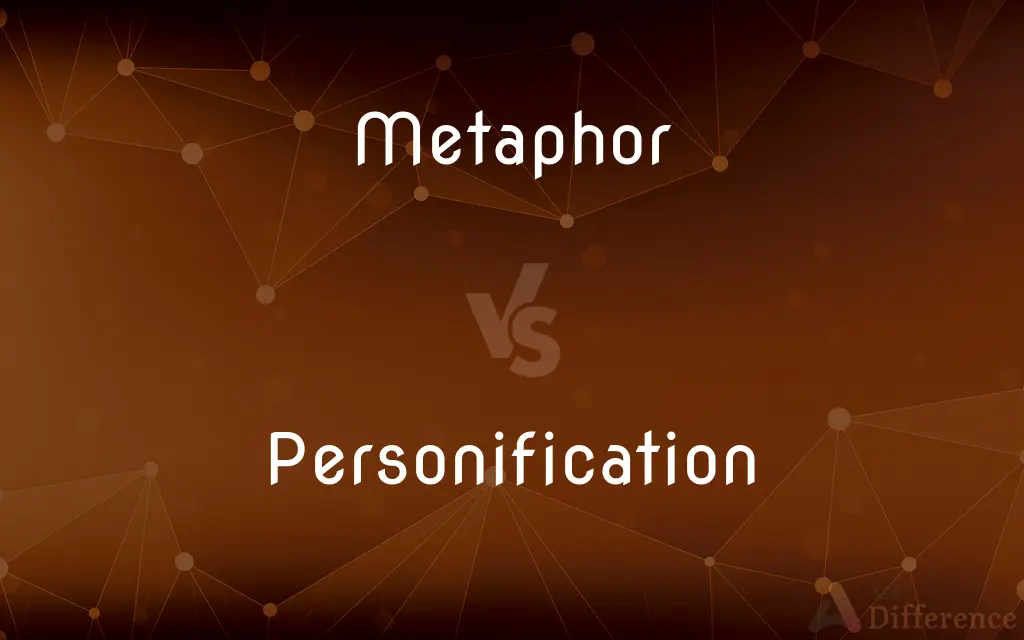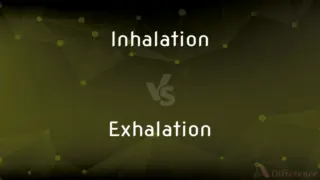Metaphor vs. Personification — What's the Difference?
Edited by Tayyaba Rehman — By Fiza Rafique — Updated on October 13, 2023
Metaphor directly equates two unrelated things, saying one is the other. Personification gives human qualities to non-human things. Both are figurative devices enhancing imagery.

Difference Between Metaphor and Personification
Table of Contents
ADVERTISEMENT
Key Differences
Metaphor is a figure of speech that makes an implicit, implied, or hidden comparison between two unrelated things that share some common characteristics. Personification, on the other hand, is a literary device where non-human objects or abstract concepts are given human-like attributes. Both serve as tools in literature to convey meanings or emphasize certain emotions.
In a metaphor, there's a direct statement suggesting that one thing is another, completely different thing. For example: "Life is a roller-coaster." Here, life (which isn't literally a roller-coaster) is compared to a roller-coaster to express its ups and downs. Personification, however, might involve saying, "The wind whispered through the trees." The wind doesn't literally whisper, but it's described as if it has human capabilities, making the imagery more vivid.
Both Metaphor and Personification are essential elements in poetry and prose, making abstract concepts more tangible and relatable. While a metaphor can vividly paint a picture by drawing parallels between two things, personification breathes life into inanimate objects, creating a more intimate connection with the reader.
Another key difference lies in their structural use. In a metaphor, the subject is equated to something else, often introduced by "is" or "was." In personification, the non-human subject performs an action or possesses a characteristic typically associated with humans. Both metaphor and personification aim to engage the reader's imagination, allowing deeper immersion into the text.
Comparison Chart
Definition
A direct comparison between two unrelated things.
Giving human qualities to non-human entities.
ADVERTISEMENT
Purpose
To create a vivid image or conceptual link.
To make inanimate objects or concepts relatable.
Example
"The world is a stage."
"The stars danced in the night sky."
Structural Indication
Often uses "is" or "was" to equate subjects.
Describes non-human entities performing human actions
Use in Literature
To draw parallels and create new meanings.
To bring objects or ideas to life, evoking emotions.
Compare with Definitions
Metaphor
A direct comparison between two unlike things without using "like" or "as."
Time is money.
Personification
A figure of speech giving human attributes to non-human entities.
The sun smiled down on us.
Metaphor
A literary tool that enhances imagery by asserting one thing as another.
The world is an oyster.
Personification
Describing non-human things as if they possess human qualities or emotions.
The wind howled in the night.
Metaphor
A figure of speech equating one thing with another to highlight a particular quality.
Her voice is music to his ears.
Personification
A literary device making inanimate objects appear alive through human-like descriptions.
The alarm clock screamed at me this morning.
Metaphor
An expression that conveys a symbolic representation.
The curtain of night fell upon us.
Personification
Infusing life into objects or ideas by attributing human characteristics.
The flowers danced in the breeze.
Metaphor
A metaphor is a figure of speech that, for rhetorical effect, directly refers to one thing by mentioning another. It may provide (or obscure) clarity or identify hidden similarities between two different ideas.
Personification
The attribution of a personal nature or human characteristics to something non-human, or the representation of an abstract quality in human form
The book provides a sustained account of how literary personification works
Metaphor
A figure of speech in which a word or phrase is applied to an object or action to which it is not literally applicable
Her poetry depends on suggestion and metaphor
When we speak of gene maps and gene mapping, we use a cartographic metaphor
Personification
A figure intended to represent an abstract quality
The knight is accompanied by two feminine personifications of vice
Metaphor
A figure of speech in which a word or phrase that ordinarily designates one thing is used to designate another, thus making an implicit comparison, as in "a sea of troubles" or "All the world's a stage" (Shakespeare).
Personification
The act of personifying.
Metaphor
One thing conceived as representing another; a symbol
"Hollywood has always been an irresistible, prefabricated metaphor for the crass, the materialistic, the shallow, and the craven" (Neal Gabler).
Personification
A person or thing typifying a certain quality or idea; an embodiment or exemplification
"He's invisible, a walking personification of the Negative" (Ralph Ellison).
Metaphor
The use of a word or phrase to refer to something other than its literal meaning, invoking an implicit similarity between the thing described and what is denoted by the word or phrase.
Personification
A figure of speech in which inanimate objects or abstractions are endowed with human qualities or are represented as possessing human form, as in Hunger sat shivering on the road or Flowers danced about the lawn. Also called prosopopeia.
Metaphor
A word or phrase used in such implied comparison.
Personification
Artistic representation of an abstract quality or idea as a person.
Metaphor
The use of an everyday object or concept to represent an underlying facet of the computer and thus aid users in performing tasks.
Desktop metaphor; wastebasket metaphor
Personification
A person, thing or name typifying a certain quality or idea; an embodiment or exemplification.
Adolf Hitler was the personification of anti-Semitism.
Metaphor
(intransitive) To use a metaphor.
Personification
A literary device in which an inanimate object or an idea is given human qualities.
The writer used personification to convey her ideas.
Metaphor
(transitive) To describe by means of a metaphor.
Personification
An artistic representation of an abstract quality as a human
The Grim Reaper is a personification of death.
Metaphor
The transference of the relation between one set of objects to another set for the purpose of brief explanation; a compressed simile; e. g., the ship plows the sea.
Personification
The act of personifying; impersonation; embodiment.
Metaphor
A figure of speech in which an expression is used to refer to something that it does not literally denote in order to suggest a similarity
Personification
A figure of speech in which an inanimate object or abstract idea is represented as animated, or endowed with personality; prosopop ia; as, the floods clap their hands.
Metaphor
A word or phrase used in an unconventional manner to draw a unique connection.
He's drowning in paperwork.
Personification
A person who represents an abstract quality;
She is the personification of optimism
Personification
Representing an abstract quality or idea as a person or creature
Personification
The act of attributing human characteristics to abstract ideas etc.
Personification
Assigning human behaviors or feelings to inanimate objects or abstract notions.
Loneliness crept up on her.
Common Curiosities
Can you give an example of a Metaphor?
"Her heart is gold" is an example of a metaphor.
Why are Metaphors important in writing?
They create vivid imagery and help establish connections or parallels between two unrelated things.
What is a Metaphor?
A metaphor is a figure of speech that directly compares two different things by saying one is the other.
How do I identify Personification in a text?
Look for non-human entities described as having human emotions, actions, or characteristics.
How is Personification used in literature?
It's used to bring inanimate objects or abstract concepts to life, making them more relatable to readers.
How does Personification differ from a Metaphor?
Personification gives human qualities to non-human entities, while metaphor directly equates two different things.
Is a simile the same as a Metaphor?
No, similes compare two things using "like" or "as," while metaphors make a direct comparison without these words.
Does Personification mean the object actually has human qualities?
No, it's a figurative device to make descriptions more vivid and relatable.
Can an expression use both Metaphor and Personification simultaneously?
Yes, "The dancing flames beckoned her closer" uses metaphor (dancing) and personification (beckoned).
What's the purpose of using a Metaphor?
To create a vivid image, conceptual link, or emphasize a shared quality between two things.
Why is Personification effective in storytelling?
It brings abstract concepts or objects to life, making the narrative more engaging and relatable.
Do Metaphors always make logical sense?
Not always. They can be abstract and open to interpretation, serving to evoke feelings or imagery.
How do Metaphors enhance understanding?
By drawing parallels between known concepts and new ones, making complex ideas more digestible.
Is Personification only used for objects?
No, it can also be used for abstract concepts like love, time, or death.
Can Metaphors be extended over multiple lines in poetry?
Yes, extended metaphors continue the comparison throughout a stanza or an entire poem, building on the initial imagery.
Share Your Discovery

Previous Comparison
Inhalation vs. Exhalation
Next Comparison
Week vs. WeakAuthor Spotlight
Written by
Fiza RafiqueFiza Rafique is a skilled content writer at AskDifference.com, where she meticulously refines and enhances written pieces. Drawing from her vast editorial expertise, Fiza ensures clarity, accuracy, and precision in every article. Passionate about language, she continually seeks to elevate the quality of content for readers worldwide.
Edited by
Tayyaba RehmanTayyaba Rehman is a distinguished writer, currently serving as a primary contributor to askdifference.com. As a researcher in semantics and etymology, Tayyaba's passion for the complexity of languages and their distinctions has found a perfect home on the platform. Tayyaba delves into the intricacies of language, distinguishing between commonly confused words and phrases, thereby providing clarity for readers worldwide.













































